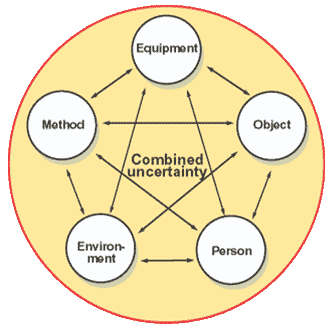When performing uncertainty analysis, it is important to consider what influences uncertainty, not errors, in measurement results. Here is a list of six common influences that will bring awareness and enlightenment to all who perform measurements.
01 | Equipment
The equipment selected to perform tests and calibrations is important. It can severely impact the uncertainty in measurement results. Hence, the reason many laboratories and professionals have been known to be very selective when purchasing equipment. Typically, equipment is the most commonly evaluated influence when performing uncertainty analysis. It is not unusual for laboratories to conduct experiments on their equipment to quantify sources of uncertainty (e.g. repeatability, reproducibility, stability, etc.). Therefore, it is important to consider what equipment will be used to perform measurements.
02 | Unit Under Test
When making measurements, it is important to consider the unit under test. Typically, the unit under test, or UUT, is often overlooked as having an influence on uncertainty. However, the unit under test can actually contribute a lot of uncertainty to the measurement result. When considering the unit under test in comparison to the equipment or standard used, it is common for the item to be less stable, have less resolution, and have an unquantified bias. All of these factors contribute to the uncertainty in the measurement result. Therefore, it is important to consider the resolution and the measurement repeatability of the unit under test.
03 | Operator
The operator who performs tests and calibrations has a major influence on the uncertainty associated with a measurement result. Their ability to facilitate the measurement process and perform quality work has a direct impact on the measurement result. Factors such as education, training, expertise, and technique can all influence uncertainty. Therefore, it is important conduct reproducibility experiments between operators to quantify the uncertainty (i.e. variability) in the measurement results as a result of the operator.
04 | Environment
The environment where tests and calibrations are performed can have an influence on uncertainty in measurement results. Variables such as temperature, humidity, pressure, gravity, elevation, vibration, stress, strain, lighting, etc. can impact the measurement result. Some tests and calibrations are more sensitive to certain environmental factors than others. Therefore, it is important to have expertise related to the specific measurement discipline or system which is being evaluated. An oversight on the influence of the environment not only impacts uncertainty, but may result in additional measurement error.
05 | Method
Test and calibration methods prescribe how a measurement process shall be performed by the operator. However, similar measurement results can be accomplished with the use of different methods (i.e. equifinality). The variability in the measurement result that is attributed to the method is what influences uncertainty. When a laboratory utilizes several methods to perform similar measurements, it is important to consider how the method will affect the uncertainty of the measurement result.
06 | Calibration Service Provider
When having equipment serviced or calibrated, it is often wise to consider who will be providing service. Service providers have a direct impact and influence on the uncertainty in measurement results via traceability. When the service provider reports an associated estimate of uncertainty on the calibration report, the value is considered the traceable uncertainty or the reference standard uncertainty. It is impossible to legitimately claim an estimate of uncertainty for a measurement result that is less than the traceable uncertainty. Dismissing traceable uncertainty as a contributor would be unethical, unprofessional, and noncompliant with international regulations and standards. Therefore, it is important to evaluate calibration service providers before conducting business with them.
When performing uncertainty analysis, it is important to consider what factors influence uncertainty. By treating the measurement process as a system and evaluating that system on a holistic level, it is easier to identify the influences and interactions that affect uncertainty in measurement results.




